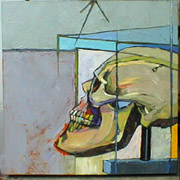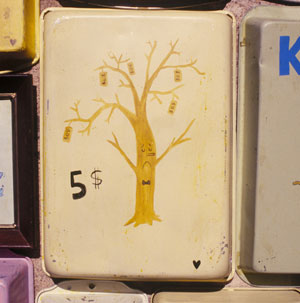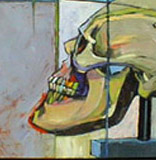Despite the press release’s claim of “bold, striking painting,” I can’t seem to get past the title long enough to concentrate on the art.
What exactly does the “attack” in the Dallas Center for Contemporary Art‘s new exhibition Painting Attack mean? This can’t be anything other than a rhetorical question, as the phrase “painting attack” fails to have any substantive meaning, at least within the context of this survey of contemporary Texas painters. Ultimately, the exhibition might as well be titled “Painting Show,” a rather bland yet fitting proposition, with some sense of ironic distance. The problem here is a lack of concentration. One can’t help wonder how hard it would have been to focus on a specific problematic (abstraction in the digital age? the flattened landscape?), and have that direct the content of the exhibition.
Given this lack of curatorial focus, each work in the show is limited in its own impact, and the lack of context inhibits dialogue between the works as well. The best of the art surmounts the rudimentary parameters of the show. The worst of it ironically fits, trying too hard to be cute, without a sense of provocation.
Of the former group, Houston artist Francesca Fuchs is a standout. Her two acrylic paintings are possibly the most accomplished stylistically in the entire show. Katrina (2002) and Bill (2003) are both portraits. The figures and the backgrounds of mundane domestic settings are both rendered in flat perspective, which creates an almost eerily sincere relationship with the subjects involved. Although they manage to look like a print ad for Apple Computer, this doesn’t lessen the psychological impact of the images; if anything, it only intensifies it. A luscious hybrid between painting and contemporary visual media such as this is exactly what a timely painting survey should explore.
nother artist who is as technically skillful and conceptually rigorous as Fuchs is Dallas-based Christopher Jagers. His two contributions here, Playroom (2003) and Greenhouse (2003) deal with issues of perception, memory, and architectonic space, and as such have predecessors in Benjamin Edwards and Matthew Richie. It is as if Jagers is taking traces of architectural blueprints and reassembling them upon infinite spatial dimensions, offering us numerous subjective spaces in which to experience them. Such layering deftly mimics the multiple abstract topographies that constitute space in modern culture. Jager’s work here is as timely as it is impossible to walk away from.
Alongisde the more accomplished artists, a handful of emerging painters and students are represented. Among the more notable are Kirsten Macy, John Ryan Moore, and Raychael Stine. They exhibit a great deal of promise, though their lack of daring provocation — which one would hope for from artists so young — is disappointing. The work of each of these artists, in differing ways, seems to be striving for a quirky aesthetic, the dogs in Stine’s canvases being the most compelling example. However, most of the work often fails to engage in a psychological or intense manner.
Although Matthew Rodriguez’s work is not specifically in the exhibition, but rather in a project space as part of the Contemporary’s ongoing Mix! Series, it’s clear that it is meant to be in dialogue with the exhibition to some degree. The Austin-based artist’s work can generally be placed within the post-graffiti tradition of artists like Barry McGee, through his technique of painting on found objects. I want to find his drawings compelling, in their obsession with childhood; but they come across as obvious and merely topographical, failing to have the emotional urgency of artists dealing with similar obsessions, such as Marcel Dzama and the Royal Art Lodge Collective. In a sense, this issue plagues much of the work in Painting Attack.
Unsurprisingly, the most interesting aspects of the exhibition stem from the artists who veer farthest from the normative parameters of “painting.” Denton-based artist Aim Adelman’s work, which consists of reflectors hung on the wall in a textile-weaving pattern, is visually stunning and conceptually productive, within the context of a painting survey. Concurrently, the piece by San Antonio-based artist Mignon Harkrader, who paints on fabric and then upholsters it onto chairs, is a fresh and welcome diversion from the more lackluster works surrounding it.
To be perfectly honest, one of the most captivating experiences the exhibition offers is not an artwork at all. It is the video you first encounter in the space — a short compilation of interviews with some artists from the exhibition, the most notable being a joint interview with Raychael Stine and Kirsten Macy. As if to mock the idea of such an exercise (and themselves, for taking part), the two artists brought a bag of fortune cookies and answered all the questions they were asked with the fortunes. ("I make art because…") On its own clever and quite charming, in the context of Painting Attack the mock-vacuousness fails to be ironic despite the artist’s intentions. This is perhaps the saddest dimension of the “attack,” that the most exciting moments can’t eclipse the curatorial void.
Images courtesy the artists and the Dallas Center for Contemporary Art.
David Michael Perez is an art historian and writer living in Dallas.






